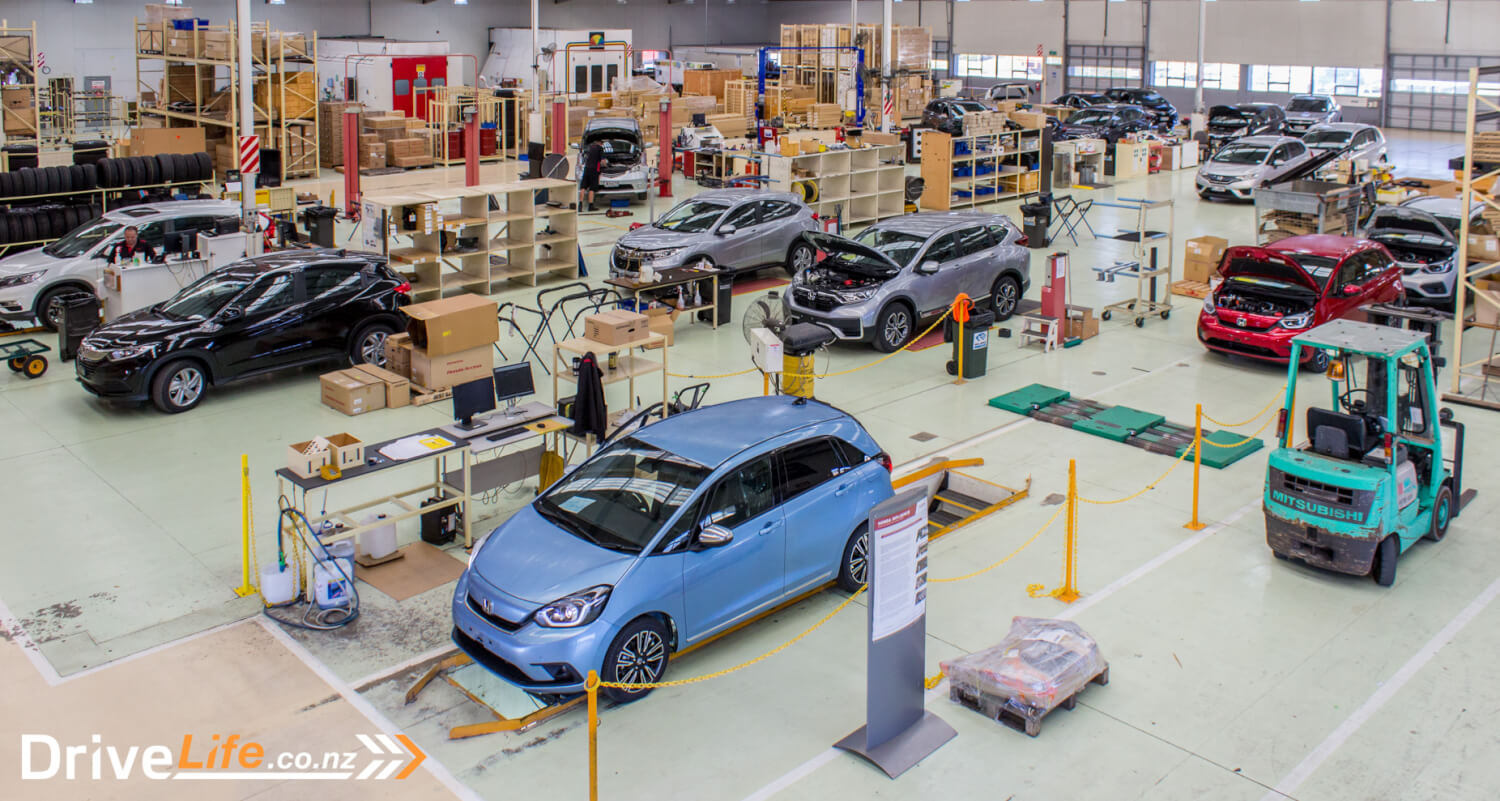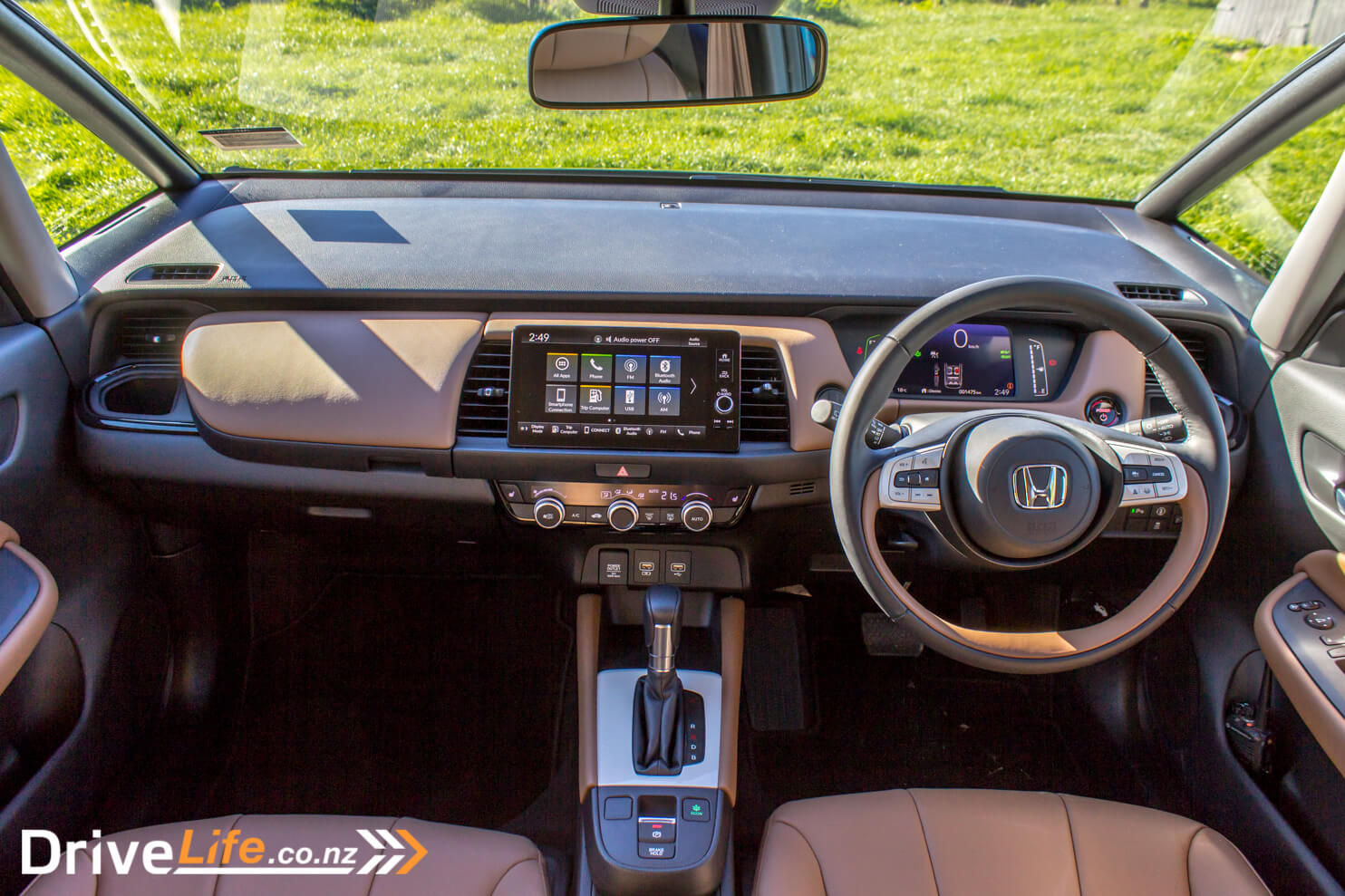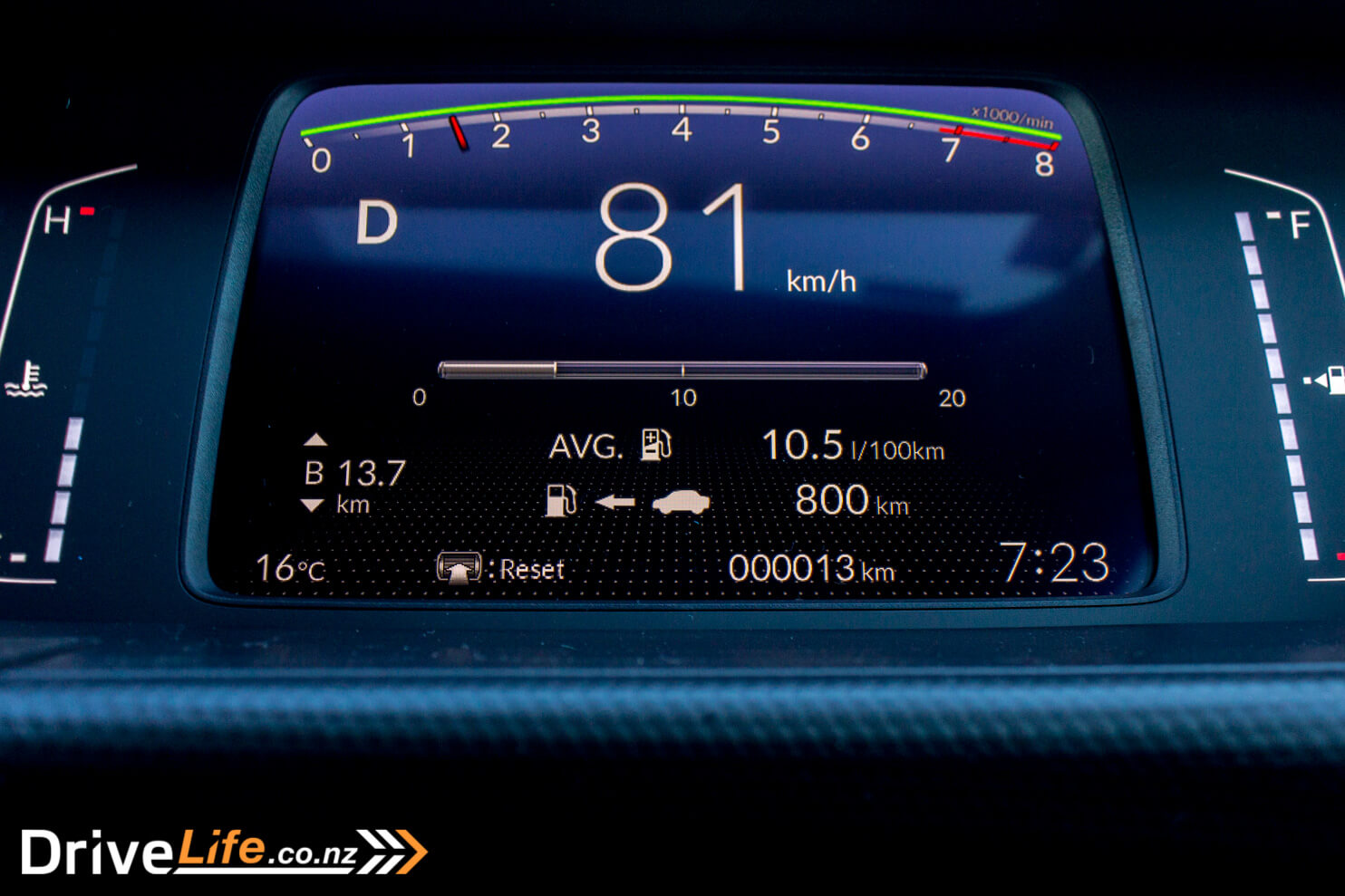A favourite of many ‘older’ buyers, the Honda Jazz has had a place in the hearts of many of New Zealand’s retired people for decades. It feels to me like they might just rock up to a Honda dealer and ask, “What’s the cheapest Honda? Jazz? Okay, I’ll take one.”
That’s not to say the Jazz is a car that isn’t worthy. It still looks good, and even though it has a CVT transmission it also goes reasonably well. And for those older buyers, there’s also Honda’s Magic Seats so they can fit in those feijoa trees from the garden centre – standing up. Magic Seats are exclusive to Honda, and we wonder why other brands haven’t adopted the idea.
I have found memories of the Jazz, even though it’s been a while since I’ve been behind the wheel. I tested the RS model in 2015 and enjoyed it. Rob Clubley tested the Jazz RS Sport Limited in the same year and he also enjoyed that car. Starting at under $23K, the current gen Jazz is pretty good value, and there’s even the option of 3 manual models.
So, what can Honda do to freshen up the Jazz and keep the micro car appealing to buyers? Adding a hybrid model could be an option, and that’s an option that Honda has taken up.
We headed to Nelson to learn about and drive the all-new Jazz.

MAN CAVE
First up was a tour of Honda’s distribution facility in Nelson. The ultimate Man Cave, this was a drool-worthy event. First off, tucked up against the wall, was a rather tasty 1965 Honda S600. Then behind this was a 1982 Honda Accord, totally original and with just over 18,000km on the clock. This car was assembled at Honda’s Panmure plant, back in the CKD days.



We were given a tour where we were told that the staff at the distribution centre have taken their attitude, learning experiences and ‘assembly mentality’ from those CKD cars right through to Honda’s distribution centre, so apparently the place runs like clockwork.
New Honda cars are given the Pre-Delivery Inspection here, as well as any accessories that need to be fitted. So ideally, the cars go to the dealer and all they will need is a quick groom and number plates.
The building also serves as a service centre, for Hondas in the area and for the Nelson Honda dealership just across the yard from the distribution centre.

DRIVE TIME
Before any presentations, we’d be heading to Upper Moutere for lunch, driving two of the three cars available.
My first car was the base model Jazz Life, finished in Wind Blue Metallic. It’s always my preference to drive the base model first, so you can get a feel for the car without being wowed by any fancy tech. I’ve got to say, that while the design is all-new, the car still carries design cues over from the previous gen. It’s unmistakably a Jazz, but looks very fresh and original.

My first surprise was getting in the car – keyless entry and keyless start in the base model? Very nice touch. It didn’t end there – there’s also climate AC, wireless Apple CarPlay and wired Android Auto along with other nice touches as standard.
Just sitting in the driver’s seat is a revelation. The front windscreen is huge, and the A pillars extremely slim, so the view out the front of the car is stunning. No visibility issues here. Even looking around from inside the car shows relatively big side windows, and clear visibility all round.

Up front I can see double gloveboxes, a drink bottle holder on each end of the dash, and gallons of room.
All three models have the same 1.5-litre, 4-cylinder VTEC engine. Attached to both lower models is a CVT automatic gearbox, which on the whole seemed to do well. Harder acceleration saw some ‘stepping’ in the transmission, making for a much nicer driving experience. This first car only had 6km on the clock, so I did take it a little easier on it. Heading out on to the open road, wind and tyre noise was minimal, and there was another highlight: the ride quality is simply excellent in this light, micro car. It glides over bumps and potholes.
The dashboard is like other Honda models, but a bit more updated. It’s still one big panel with temperature and fuel gauges on the outside edges but it is an improvement at least.

One of the other big tech improvements is the central display and infotainment system. Honda have really nailed this; it’s crisp, clear, and simple to use, and a world away from the systems still used in the HR-V and CR-V. Hopefully in time those models will also get this upgrade.

Still on the open road, we took a turn and headed to much more twisty roads to get to our lunch destination. The little Jazz ate these roads up. It may be only a shorter drive today, but the car stuck to the corners, and even bumps mid-corner did nothing to upset the handling. The steering could do with more feel and there is some body roll at times, but overall it’s a fun and safe little car on bendy B roads.
We stopped halfway and I switched into the new e:HEV models, my car finished in Premium Crystal Red Metallic, and looking excellent. e:HEV is Honda speak for a hybrid. It’s not a plug-in hybrid, but more a conventional one like a Toyota Prius. I was a bit worried here; after experiences with the Suzuki Swift Hybrid and the Subaru Forester Hybrid, I thought Honda might have given us a ‘mild’ hybrid, which would be disappointing.

Well, they haven’t, and the new Jazz e:HEV is excellent. It will not start the engine automatically at 50km/h as the Prius does, and can comfortably cruise in EV mode without drama. The battery capacity is large at 35kWh according to Honda (TBC), and there’s also a B mode for the transmission in this model, so you can select this and use more severe regenerative braking to get extra charge into the batteries. I don’t believe the rating for the battery is correct, as the new Mazda MX-30 EV has a 35kWh battery, and that car is $75K.
It also has a battery level meter in place of the temperature gauge so you can watch the battery charge up using that regenerative braking. You don’t have any control over the hybrid side of things in the car; other than the B mode for the transmission, there’s nothing you can do to force the car to drive in EV mode. In saying that, you don’t need to. The system seems very intelligent, and switching from EV mode to hybrid mode to engine-only mode is automatic and seamless. You simply can’t tell it’s happening other than ‘EV’ coming up on the dash, or hearing the engine noise at higher speeds.

I noticed that on the way to the swap-over point, the Life model was sitting on 8.6L/100Km. Not a great number for a 1.5, but perhaps that tight engine wasn’t helping. The e-HEV was showing me 5.2L/100km, a big improvement. This car also had almost no miles on the clock, as did all the cars we were in today. As a guide, Honda suggests the e-HEV should return just 2.8L/100km making it the most economical non plug-in hybrid on the market. We’ll have to wait until we do a full review to see if we can match that number under normal driving conditions.
We got to Moutere Hills Winery for lunch, and time for presentations telling us all about the new Jazz.
TALK TIME
According to Matt Woodburn, Marketing and Product Manager at Honda NZ, the “Next Gen Jazz” is aimed to fit two purposes; a rational side and an emotional side. This lines up with a common Japanese saying, Yoo No Bi which means ‘pleasant athletics’ and these would become the key concept words for this new generation of Jazz.
This is the 4th gen in the model’s 20-year history, and for the look of the new Jazz, the design team looked at the first Honda Logo – the Jazz’ predecessor- and compared it to 1st Jazz, and went from there. According to Matt, this new Jazz has the biggest changes in the car’s history, with its smiley face and other design alterations, as well as the drivetrain and tech upgrades.

The car now has bigger headlights, but Honda have purposely avoided giving the car a bigger grille as seems to be the current favourite design trend. The front is nice and simple, with full LED headlights across the range. There’s also LED taillights as standard, with the uplines on the “sides smooth and uplifting” he says.
MODEL LINE UP
You get to pick from three models; the Life, the Crosstar, and the e:HEV Luxe.
Life
All models are front-wheel drive, have 16” alloy wheels as standard as well as a 9” central touchscreen display, front and rear parking sensors, keyless entry and start, wireless Apple CarPlay, power folding exterior mirrors, privacy glass, a 7” driver’s information display, and LED daytime running lights. Android Auto is also standard but you need to plug a USB cable to use it.
All are powered by a 1.5-litre, 4-cylinder VTEC petrol engine, putting out 89kW of power in the Life and Crosstar, and 72kW in the e:HEV Luxe. All run an electronic constantly variable transmission (CVT).
Crosstar
Like the Yaris Cross, the Crosstar takes on a different look from the Life and e:HEV Luxe models. It has integrated roof rails, different bumpers front and rear, plastic wheel arch guards and sills, waterproof fabrics used inside, unique suspension tuning which including a lift that’s 28mm higher than the other models. This ride height is accomplished by higher profile tyres and suspension changes. There’s an exclusive body colour for the Crosstar called Surf Blue, and it’s this model’s hero colour – and it looks brilliant in it.

Only the Crosstar is available with two-tone paint. It also has auto headlights, a leather steering wheel, as well as different door cards, dash and seats. There’s LED fog lights and a security system on this model.
Since there’s no hybrid version of the Crosstar (yet), it does mean the Yaris Cross Hybrid has one over the Crosstar at this time.

e:HEV Luxe
This is the top-spec of the range, and along with its hybrid drivetrain, it has other extras like a full leather interior (including a tan option), Honda’s SENSING safety system, heated front seats, platinum exterior detailing, “lounge design” rears seats, rear USB ports, slightly uprated suspension for the extra weight of the hybrid system, and padded ‘Prime Smooth’ finish on doors and dash.
There’s a hero colour for the e:HEV Luxe as well, and that colour is Meteoroid Grey.

INTERIOR
Up front, there’s a flat dash design for better visibility along with those slim pillars, forward visibility has gone up from 69 to 90.2 degrees. There’s been a lot of design and engineering work on front pillars to reduce blind spots, as this was a common observation of owners. There’s also hidden windscreen wipers, which aren’t actually hidden under the bonnet but they are not in the driver’s line of sight. I can attest this these changes really work – the view out the front of the car is simply amazing.
Honda have introduced anti-fatigue seats as standard, hopefully meaning that while it’s a micro car, a journey to Auckland back would not be uncomfortable. There’s other design tweaks for a more comfortable drive, like a redesigned shift lever, and padded knee pads on centre console.
For the first time, Honda have also introduced a Simple Mode for the dash, to reduce the amount of info shown so the driver can focus. There’s also a Mood Control setting.
Steering and pedal positions have been adjusted after complaints on previous gen, and there’s an extra 14mm of movement in the steering wheel for taller drivers.
Overall, the exterior dimensions are almost same as the old model, although it sits around 10mm lower. Thankfully, Honda have once again given this new Jazz its Magic Seats, and for easier loading, there’s a low lip at rear of the car. Under the floor in the boot is a small storage compartment that gives you an extra 14 litres of space, while boot space in the e:HEV is 304 litres with the rear seats up. The non hybrid models have a slightly bigger boot.

Dash panel storage is back and this was something I noticed straight away. People love having extra places to store their packets of chewing gum and stuff, so this will be well received. Another nice touch is the smart phone holders on rear of the front seats, so passengers can stick their phone in the holder and watch videos without having to hold the phone.
e:HEV Luxe
For the first time in New Zealand, Honda is offering a hybrid version of the Jazz. This model is a two-motor hybrid, although these are both in the transmission, and one is the generator/electric motor, so it’s not quite what you’d expect. The e:HEV is still front-wheel drive only.
The electric motor gives you a decent 253Nm of torque, and requires no driver input. There is a slight difference in the way this hybrid system works, compared to say a Prius. The car will run in EV mode when it can, the next mode is Hybrid; in Hybrid mode, the engine will start but it will only charge the batteries up, it doesn’t drive the wheels. The last mode in Engine Only, and this will drive the wheels with no electric input, unless full-throttle acceleration is required, when the electric motor will assist. Generally, Engine Only mode is for highway speeds.

The air-cooled, lithium ion battery pack is a claimed and huge 35kWh in size, and is stored in the boot below the floor. While the petrol engine puts out 89kW of power in the non-hybrid models, its detuned for hybrid use down to 72Kw. The electric motor is 80kW, and manages 253Nm of torque. With a 40-litre fuel tank, Honda suggests a range of 1,400km. When I jumped into the e:HEV it said 959Km of range. Still excellent for a 40-litre tank.
What about the old 1.3-litre Jazz? That engine has gone, along with a manual gearbox option.
ENGIEERING
There’s been a major redesign of the suspension in the new Jazz, with things like die cast alloy suspension parts, and engineering tweaks to all allow the wheels to follow undulations on corners. It sure felt this way in the short drive this morning.
Reduced road noise has been accomplished through new noise absorbing materials, double door seals, and there’s now a plastic transmission mount to reduce vibrations.
TECH
The reversing camera now has dynamic reversing lines, and has 3 angles to choose from – very handy.
Honda Sensing is improved and fitted to the e:HEV Luxe, and this includes a wide-view front camera. Apparently it has 100 degrees of vision, and is much better at detecting other cars cutting in front of you, for example, meaning smoother deacceleration while the car adjusts to the new hazard. It also means better front vehicle detection, lane departure warning is improved, lane keep assist is better, and there’s now collision mitigation braking,
2021 HONDA JAZZ PRICING
- Life: $28,000
- Crosstar: $30,000
- HEV: $35,000
While there’s a $5,000 increase over the previous base model, there’s no doubt this new Jazz has far more features, safety, comfort and drivability than the third gen.
We will do our normal full review, once we get a new Jazz on test.














































This is probably not the place to ask this. My husband and I are retired, he being 91. We bought a new Honda Jazz RS in 2019 and I am quite happy with it but my husband finds the suspension and seats very hard on his frail body. I would like to take him out for drives and wonder if something could be done about his comfort or would I have to buy a different car. I hoping you will be able to advise me.
Regards Cushla.
Hello Cushla
We’ve driven the 2019 Jazz, and I think it would be worthwhile you taking him out in the new model. It’s quite a bit different, and you might find that the new model is the right car for you as far as seats and suspension goes.